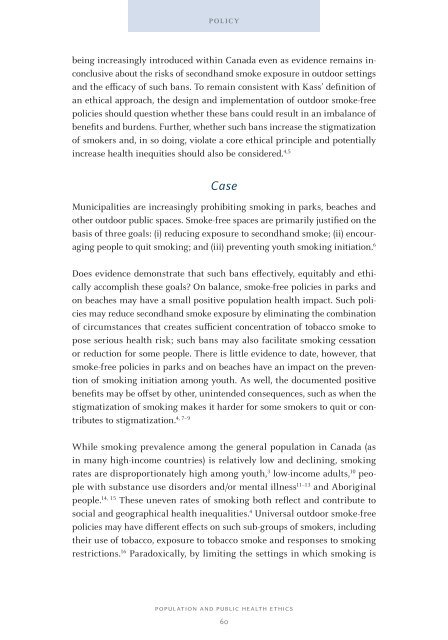PoPulationand Public HealtH etHics
PoPulationand Public HealtH etHics
PoPulationand Public HealtH etHics
Create successful ePaper yourself
Turn your PDF publications into a flip-book with our unique Google optimized e-Paper software.
policy<br />
being increasingly introduced within Canada even as evidence remains inconclusive<br />
about the risks of secondhand smoke exposure in outdoor settings<br />
and the efficacy of such bans. To remain consistent with Kass’ definition of<br />
an ethical approach, the design and implementation of outdoor smoke-free<br />
policies should question whether these bans could result in an imbalance of<br />
benefits and burdens. Further, whether such bans increase the stigmatization<br />
of smokers and, in so doing, violate a core ethical principle and potentially<br />
increase health inequities should also be considered. 4,5<br />
Case<br />
Municipalities are increasingly prohibiting smoking in parks, beaches and<br />
other outdoor public spaces. Smoke-free spaces are primarily justified on the<br />
basis of three goals: (i) reducing exposure to secondhand smoke; (ii) encouraging<br />
people to quit smoking; and (iii) preventing youth smoking initiation. 6<br />
Does evidence demonstrate that such bans effectively, equitably and ethically<br />
accomplish these goals? On balance, smoke-free policies in parks and<br />
on beaches may have a small positive population health impact. Such policies<br />
may reduce secondhand smoke exposure by eliminating the combination<br />
of circumstances that creates sufficient concentration of tobacco smoke to<br />
pose serious health risk; such bans may also facilitate smoking cessation<br />
or reduction for some people. There is little evidence to date, however, that<br />
smoke-free policies in parks and on beaches have an impact on the prevention<br />
of smoking initiation among youth. As well, the documented positive<br />
benefits may be offset by other, unintended consequences, such as when the<br />
stigmatization of smoking makes it harder for some smokers to quit or con-<br />
4, 7–9<br />
tributes to stigmatization.<br />
While smoking prevalence among the general population in Canada (as<br />
in many high-income countries) is relatively low and declining, smoking<br />
rates are disproportionately high among youth, 3 low-income adults, 10 people<br />
with substance use disorders and/or mental illness 11–13 and Aboriginal<br />
people. 14, 15 These uneven rates of smoking both reflect and contribute to<br />
social and geographical health inequalities. 4 Universal outdoor smoke-free<br />
policies may have different effects on such sub-groups of smokers, including<br />
their use of tobacco, exposure to tobacco smoke and responses to smoking<br />
restrictions. 16 Paradoxically, by limiting the settings in which smoking is<br />
PoPulation anD <strong>Public</strong> <strong>HealtH</strong> <strong>etHics</strong><br />
60
















